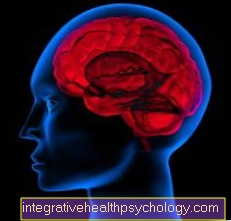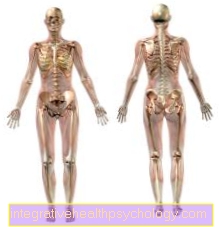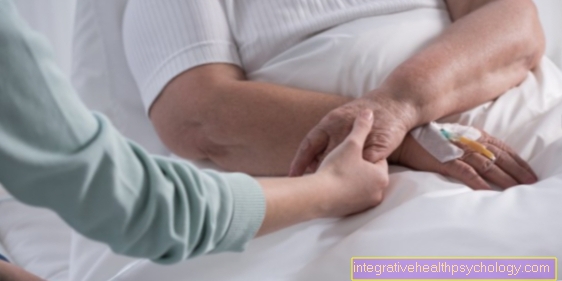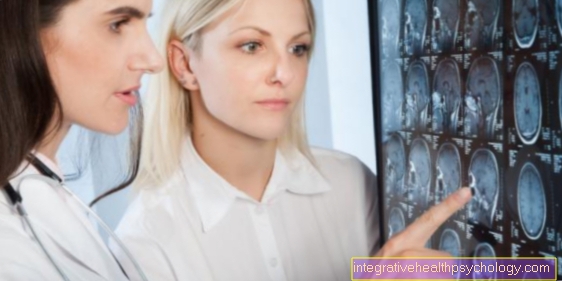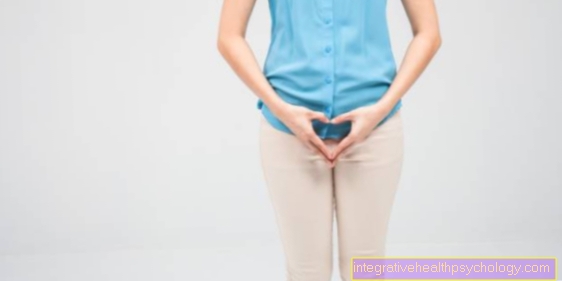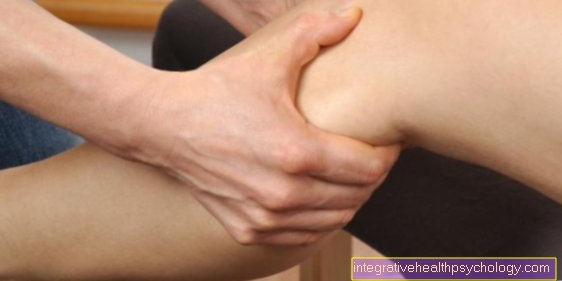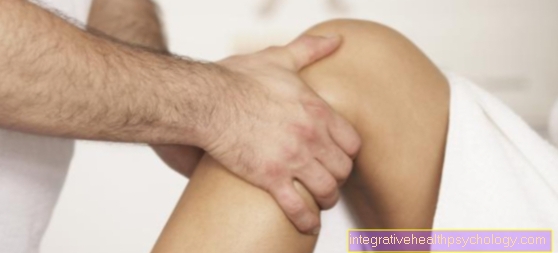Parkinson's disease
Synonyms
- Paralysis
- idiopathic Parkinson's syndrome
- Tremble
- Tremor sickness
- Parkinson's disease
introduction

Parkinson's disease or "Parkinson's disease" owes its name to an English doctor. This doctor, James Parkinson, already described the symptoms typical for the disease that he observed in various of his patients at the beginning of the 19th century. He himself initially named the disease "paralysis".
Only 100 years later, a corresponding brain examination could a connection between the typical symptoms and changes in the brain, more precisely in the midbrain, be proven.
Epidemiology
Overall, Parkinson's disease is one of the most common diseases of the so-called "central nervous system", that is to say of the brain and the attached spinal cord.
In Germany, almost 250,000 people suffer from this disease.
The disease typically occurs in older people in the 5th or 6th decade of life.
However, there are also very early forms of the disease that can occur as early as the age of 30.
What is actually the difference to Parkinson's Syndrome? - Find out everything about Parkinson's Syndrome here
causes
Basics of the nervous system
For a better understanding of a nervous disease such as Parkinson's disease, some basics of the nervous system should first be shown below.
The actual nervous system of the human body consists of 2 parts. On the one hand there is the brain with the attached spinal cord. This part is called the so-called "central nervous system". For another, there are a multitude of nerves that run through the whole body. This is called the so-called "peripheral nervous system".
Read more on the topic: What is Oxidative Stress?
Figure nerve ending

- Nerve endings (dentrite)
- Messenger substances, e.g. Dopamine
- Other nerve endings (dentrite)
Both systems consist of individual Neuronswho are in contact with each other. The places at which such contact takes place from one cell to another are called "Synapses ". This is where it is decided (similar to when crossing a border) whether cell A will "let through" information to cell B.
This information is collected with the help of so-called. "Messenger substances" (Neurotransmitters) transmitted. If a cell receives an impulse, it passes it on with the help of the messenger substances.
At the synapse a certain one is created for this purpose Messenger substance released that clings to the "neighbor synapse" like a key in a lock. This triggers another impulse in the neighboring cell, which in turn generates a Transmitter release evokes. The actual impulses in the nerve cell are tiny electrical charges that pass through the nerve cell from one synapse to the next.
Such a "data transfer" naturally works extremely quickly.
All nerve cells are in some way related to the big one Control organ "brain" together. The brain itself is divided into different areas that perform certain functions (language, vision, movement, etc.).
If it comes to one of these areas Damage, all neurons associated with this region are also affected.
The signals from the brain are transmitted through the "peripheral nervous system"as if routed through the whole body by electric cables. These lines are also responsible for conducting stimuli to the brain. (temperature, pain, touch, etc.)
Example: nerve conduction
One of the most impressive experiences in terms of Nerve conduction is the phenomenon when you stub your little toe and it takes about a second to do that Pain signal in the brain has arrived.
If you try to imagine the above-mentioned mechanism of stimuli and messenger substances, it is quite understandable that the whole Information line gets disturbed when it suddenly too few neurotransmitters gives. A pulse then only triggers a very weak follow-up pulse.
Example: neurotransmitters
If you imagine that you would need 100 keys to unlock 100 power boxes to create a certain voltage, you can imagine that just 10 keys can lead to an overall very unsatisfactory result.
With various diseases, u. a. also in Parkinson's disease, there is a reduction in an important messenger substance (in Parkinson's this is called dopamine)
Too much transmitter material can also lead to problems. To stay with the above example, too many keys for a few locks can trigger a "continuous fire" of pulses that mess up the information chain.
(Such a mechanism is used today for the development of schizophrenia held responsible.)
What happens now with Parkinson's disease?
Parkinson's disease is an imbalance of neurotransmitters in a certain area of the brain (basal ganglia). This area of the brain is especially responsible for carrying out conscious movements.
In order for a person to be able to carry out movements without problems, it is necessary that the messenger substances "acetylcholine", "glutamate" and "dopamine" are in a certain ratio to one another in this area.
In Parkinson's disease, there is a lack of dopamine, so that there is a "relative" excess of acetylcholine and glutamate.
"Relative" in this context means that, although there is actually no more of the transmitter, it is used longer and more frequently due to the lack of the other substance.
Acetylcholine in particular, which is very important for muscular movements, now causes the symptoms of "muscle tension" (rigor) and "tremors" (tremor) through this "transmitter imbalance".
The dopamine deficiency is blamed for a typical "sedentary lifestyle".
Read more on the topic: Acetylcholine
Where does the dopamine deficiency come from?
Dopamine is produced in a certain area of the so-called midbrain, the "substantia nigra", this is a region that turns black in brain studies. In Parkinson's disease, this region of the brain is slowly and progressively destroyed, so that less and less dopamine can gradually be formed.
Today medicine cannot (yet) name the reason that is responsible for the downfall of the "substantia nigra".
Only when more than 2/3 of the dopamine produced is missing do Parkinson's symptoms develop.
Concomitant symptoms
Other accompanying symptoms:
Balance disorders
Many of those affected also suffer from disorders of their balance. These can occur when you are simply walking and can also increase if you are distracted at the same time. If the diagnosis is confirmed, it is therefore advisable to do things one after the other (e.g. stop first and then pull the cell phone out of your pocket).
Mental changes
Unfortunately, depression is not uncommon in Parkinson's disease.
On the one hand, as already described, there is a change or shift in the balance of transmitter substances (see also topic Antidepressants), on the other hand, such a disease with all its limitations naturally also means that a patient definitely has one because of the severity of the disease depression can develop
The actual "thinking" can slow down as part of the disease. However, intellectual abilities are typically not affected.
Other physical side effects (vegetative symptoms):
It can also occasionally lead to other physical symptoms such as increased Sweating, constipation, Difficulty in Urination or dizziness come.



